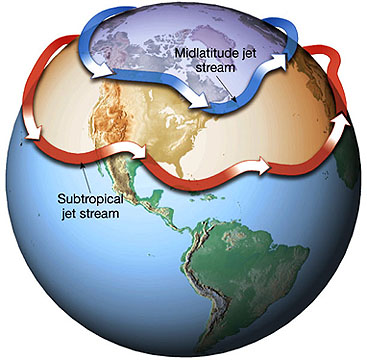jet stream
A JET STREAM IS A relatively narrow band of strong horizontal winds in the atmosphere. This band is 100 to 200 mi (250 to 500 km) wide and 1 to 2 mi (several km) deep. The winds in this band are stronger than those in horizontal or vertical regions adjacent to this band. The boundaries of the jet stream, therefore, contain significant wind shear. Traditionally, the term jet stream has referred to such bands that occur in the upper troposphere, especially those that consist of westerly winds. There are other atmospheric phenomena that consist of bands of strong winds. The tropical easterly jet consists of easterly winds and is associated with the Asian monsoon. The polar night jet occurs during the winter in the stratosphere. Low-level jets form at the top of the planetary boundary layer—usually at a pressure of 900 to 800 mb. These jets have been associated with thunderstorm activity in many parts of the world.

Military pilots discovered the upper tropospheric westerly jet streams during World War II. Aircraft flying in an easterly direction would sometimes encounter winds so strong that they would seriously impede their mission. There are two types of these westerly jets: the subtropical jet and the polar front jet. The jet streams are located 30,000 to 40,000 ft (9 to 12 km) above the Earth's surface. They tend to be higher in summer than in winter and the subtropical jet is usually higher than the polar front jet. Meteorologists generally consider these jets to have wind speeds in excess of 60 mi (97 km) per hour. Average winds are about 135 mi (217 km) per hour in winter. The location of the most intense winds varies from day to day.
The subtropical jet stream forms as a result of the physical principle of the conservation of angular momentum. Figure skaters use this same principle to increase their spinning rate by bringing their arms
towards the center of their bodies. Air is heated and rises over the part of the globe receiving the strongest solar radiation. At the top of the troposphere, this rising air moves toward the poles. As it moves toward the poles, the distance between it and the Earth's axis decreases. As this distance decreases, the air accelerates toward the west. The air reaches its maximum westward velocity between 20 and 40 degrees from the equator and then starts sinking. The latitude of maximum winds tends to be more poleward in the summer and more equatorward in the winter. Wintertime jets tend to have faster speeds than summertime jets. The intensity of the jet varies with longitude, but there is a tendency for it to be stronger off the east coast of Asia.
As its name implies, the polar front jet stream forms along the polar front, where warm air from the tropics meets cold air from the poles. The strong temperature contrasts that exist here cause south to north pressure gradient to increase with height. The intensity of the pressure gradient increases up to the troposphere. The Coriolis force then causes winds to go from west to east. This jet stream is also more intense and located more poleward during the winter than during the summer.
Within both types of jet stream there are regions where winds are stronger than those located both upstream and downstream. Such an area is known as a jet maximum or jet streak. Air flows through the jet maximum accelerating in the entrance region and decelerating in the exit region at an average speed of 125 mi (201 km) per hour. The jet maximum has a distinct structure with areas of convergence in the poleward entrance region and equatorward exit region and areas of divergence in the poleward exit region and the equatorward entrance region. Below areas of divergence, especially the one on the poleward side, are especially favorable areas for midlatitude cyclones to develop.
Jet streams affect our daily lives in other ways as well. Since the polar front jet stream is located where the north-south temperature gradient is strongest, places that are south of the current location of the jet stream tend to have warmer than normal temperatures and places to the north, colder than normal temperatures. The location of jet streams is very important to aviators. Aircraft flying with the jet stream can get a tailwind and aircraft flying against it, a headwind. These winds can significantly influence travel time and fuel consumption. The areas bordering jet streams have high wind shear and are prone to develop turbulence.